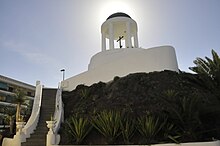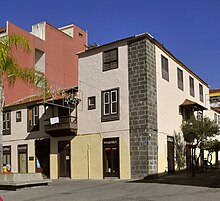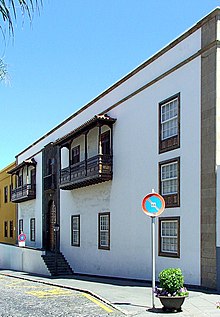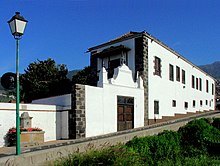Attractions in Puerto de la Cruz
The sights in Puerto de la Cruz represent a period of more than four centuries of architectural history and thus the stylistic diversity of the city on the Spanish island of Tenerife .
Tourist facilities
Jardín Botánico
Although the botanical garden was not planned as a tourist facility, it has been an attraction for foreign visitors for centuries. The "Jardín de aclimatación de La Orotava", as the garden is still called today, is not in Orotava, but on the southeastern outskirts of Puerto de la Cruz. He was in 1788 on behalf of King Charles III. by Alonso de Nava y Grimon VI. Marqués Villanueva del Prado laid out. The location was chosen so that the garden was on the one hand close to the harbor so that the plants from overseas did not have to be transported far. On the other hand, it should be at a height of about 100 m above sea level, in a place where there was enough water available. As the garden became very neglected in the course of time, it became a garden with international renown after 1860 through the efforts of the Swiss head gardener Hermann Wildpret . The Jardín Botánico is now under the direction of the Canarian Institute for Agricultural Research.
Loro Parque
The animal park "Loro Parque" on the western outskirts of Puerto de la Cruz shows, among other things, gorillas , white tigers , sharks and turtles . In addition to the famous parrot collection from which it is named, the highlights of the park are the largest dolphin show in Europe and the largest penguin collection in the world. Among other things, the dolphin footage at the beginning of the 2005 movie " The Hitchhiker's Guide to the Galaxy " was filmed here. Since June 2006 the zoo has had a large orca pool with a 3,000-seat stadium.
Plaza del Charco
The meeting point and center of the city, especially among the locals, is the Plaza del Charco ( Puddle Square ). The buildings on the west side of the square, in which restaurants and cafes are now housed, originate from e.g. Some of them from the 17th century. Their facades, however, were repeatedly adapted to the style of the time. In the inner courtyards, one can still recognize the former artistic design of the buildings by the galleries, which were built by merchants as residential and commercial buildings. The building known today under the name Rincon del Puerto was an inn in the 19th century, in which both the later Emperor Maximilian of Mexico and the later Russian Tsar Alexander III. stayed overnight.
Plaza de la Iglesia
The Plaza de la Iglesia is a square that was planned when the city was first planned in 1603. On the east side, the church of Nuestra Señora de la Peña de Francia was built at the end of the 17th century. On the west side there was the monastery of St. Catherine until 1925, which has served various purposes since the disamortization . Today there is a school on the property.
The current design of the square dates from around 1900. In the middle of the square there is an Art Nouveau fountain, also built in 1900, which has the shape of a swan with water gushing from its beak.
Boardwalks
The wide Avenida Colón beach promenade, completed in 1961, was modernized from 2002 to 2005 and leads from Playa Martiánez in the east past many hotels, cafés, bars, shops and the Lago Martiánez open-air swimming pool on the seafront, designed by the architect César Manrique, to the Paseo de San Telmo on Playa Jardín, another beach promenade.
Playa Jardín
The Playa Jardín ("garden beach") is an artificially created beach made of black volcanic sand, which is embedded in a park landscape and protected with artificial breakwaters. It is located on the western edge of Puerto de la Cruz, between the fortress Castillo San Felipe and the incorporated fishing village of Punta Brava. The planning for the bathing beach began in 1986, the final design of the beach with an artificial waterfall was made by the Canarian architect César Manrique . The opening took place in 1994.
Listed buildings
Nuestra Señora de la Peña de Francia church
The chapel, which Antonio Franchi y Lutzardo had built in 1603, was used as a parish church from 1631, expanded from 1648–1697 and expanded in the 18th century.
San Francisco Church and San Juan Bautista Chapel
The Church of San Francisco was the church of the Franciscan monastery that was dissolved in the 19th century and burned down in 1967. The current front side chapel was built around 1600 as the Chapel of San Juan Bautista. The church contains some notable works of fine art.
San Telmo Chapel
A predecessor church to today's San Telmo Chapel seems to have been built within the San Telmo fortifications at the beginning of the 16th century. The current building dates back to the founding of the seaman's guild in 1780. In 1826 the church was badly damaged by a flood. After a thorough restoration in 1880, only a few changes were made. In 1968 the chapel was restored with great support from the Catholic Foreign Secretariat of German-speaking Catholics. Since this renovation, the Catholic German-speaking community has been taking care of the chapel and celebrating their Sunday and weekday services in this chapel together with tourists and residents. Behind the church there is still a round building that represents the entrance to the underground powder store of the fortification.
San Carlos Cemetery
The cemetery was laid out in 1810. The cemetery chapel dates from 1840. A large number of the city's important personalities were buried in this cemetery. Many of the family graves of these personalities are still used today by their descendants. For some years now, non-Catholic deceased have also been buried in the cemetery.
La Chercha / Cementério protestante
The English churchyard is the oldest modern non-Catholic cemetery in Spain. It was officially created between 1713 ( Peace of Utrecht ) and 1757. All non-Catholic deceased were buried here. This applied to Protestants as well as to Jews and non-denominationalists. Apparently, Muslims were never buried here. The graves of many people who were of great importance to the city have been preserved in the cemetery.
El Peñón del Fraile
The name Peñón del Fraile goes back to the brother Juan de Jesús, who climbed the rock ( Peñón ) every day to pray there. At the end of the 18th century, the temple was built on behalf of Luis-Carlos Lavaggi de Camilli. In 1814 the staircase was built at the community's expense.
Castillo San Felipe
The fortress was built at the beginning of the 17th century to protect the landing bay in the mouth of the Barranco Felipe from pirates. The powder magazine, a little inland, was connected underground to the main building. The facility was equipped with four cannons and offered accommodation for a crew of 35. The Castillo was badly damaged in a great flood in 1826. It was restored at the end of the 20th century and is now used for cultural purposes.
Casa Rixo (Casa Hernández)
The building was erected in the 18th century. The appearance of the facade, which points towards Calle Blanco, shows classic architectural elements. A style popular with the city's affluent population during the Enlightenment . Jose Agustin Alvarez Rixo (1796-1883) mayor of Puerto de La Orotava, writer and historian lived in this house.
Casa Iriarte
The building is an example of a residential and commercial building from the late 17th century. The facades facing Calle San Juan and Calle Iriarte have balconies typical of the Canary Islands. In this building was Juan de Iriarte y Cisneros and his nephew Bernardo de Iriarte y Nieves Ravelo , Domingo de Iriarte y Nieves Ravelo and Tomás de Iriarte y Nieves Ravelo born.
Casa de la Real Aduana
Until the beginning of the 19th century, the Casa de la Real Aduana served as a residential and service building for the customs administrators. The building was built by Antonio Luzardo de Franchi in the early 17th century. Since 2007, the Museo de Arte Contemporáneo Eduardo Westerdahl (Museum of Contemporary Art Eduardo Westerdahl ) of the Instituto de Estudios Hispánicos de Canarias , one of the most important collections of international fine art from the period from the 1920s to the present day, is on the 1st floor of the Casa de la Real Aduana housed. The city's tourist information office and local handicrafts point of sale are located on the ground floor.
Casa Miranda
The building was built in 1730 as a residential and commercial building. It is an excellent example of Canarian architecture. Particularly noteworthy is the double balcony on the lake side. The house belonged to the father of Francisco de Miranda , a champion of Venezuela's independence. In the 1960s, Austin Baillon, the director of Shell International, bought this house and customs house and saved the houses from demolition. Today the building is used as a restaurant.
The archeology museum
A museum of pre-Hispanic history was established in the early 19th century house in 1991. This museum brings together different collections that give a good overview of the finds from the history of Tenerife before the time of the Spaniards.
Hotel Marquesa
In 1712, Nicolás Valois had the building erected near the church. The name of the hotel goes back to the Marquesa de Candia, who used to live here. The house was converted into a hotel in 1887 and completely renovated in 1964. During his stay in Tenerife, Alexander von Humboldt stayed here as a guest of the then owner Bernardo Cólogan y Fallon.
Hotel monopoly
The original building was erected in 1742. It has been used as a hotel since 1888, under the name Monopol since 1905 . In 1960 the house was expanded in the style of the Neo-Canario . The engineer Agustin de Betancourt y Molina was born in the building. He was the first director of the Civil Engineering School in Madrid and achieved the rank of general in the Russian army at the time of Tsar Alexander I.
Casa Rahn
The building was built at the end of the 18th century on the site of the former Dominican monastery, Chapel and Hospital of St. Pedro González Telmo. The monastery burned down in 1778. The facade was modeled on the old monastery facade in 1781 by José Bethencourt y Castro. After the disaster , the dealer Luis Rodríguez bought the house. Here his son Luis Rodríguez Figueroa was born. The well-known writer and Republican MP was murdered in 1936.
Casa Reimers
The house was built after 1741 by Diego Little, a merchant from Ireland, as a residential and commercial building. The current name of the building goes back to its last owners, the Reimers family.
Casa Hermanos de la Cruz Blanca
The house used to belong to the Scottish Pasley family, who ran the most important trading company in the Canary Islands in the middle of the 18th century. The house was later taken over by the Reid family, whose members were also of great importance as British consuls. From 1936 to 1974 the Colegio de la Pureza de Maria was housed in the building . Today the house houses the Hermanos de la Cruz Blanca .
Casa and Torre Ventoso
The residential and commercial building was built in the middle of the 18th century for the Lynch family. Later the White (Blanco) family had the tower built. At the end of the 19th century, Victoria Ventoso y Cullen (1827–1910), a poet and her husband Dr. Víctor Pérez (1827–1892), doctor and promoter of tourism here. The buildings were renovated in the middle of the 20th century. The house was last used as a school ( Colegio San Agustin ).
Casa Sol
In this house from the second half of the 18th century, which at the time belonged to Bernardo Ascanio y Molina, the English carpenter Jackson is said to have operated the first hotel in Puerto at the beginning of 1814.
Lago de la Costa de Martiánez
The listed complex from the early 1970s basically consists of three parts: The first part consists of three swimming pools and a restaurant terrace in the west of San Telmo. In this area of the complex, angular floor plans predominate. The second area is a group of three swimming pools. Here the influence of the landscape designer César Manrique can be seen in the shapes, the white surfaces and the inclusion of the plants. To the east is the third area called El Lago ( the lake ). Various islands and peninsulas are arranged on a large body of water. There are various sculptures within the complex that form part of the overall work. The architect and artist used natural elements such as lava stones and the operation of the pool also corresponds to this concept, as the water in the pools is fed from the surrounding sea. The Lago Martiánez swimming pool is the largest seawater swimming pool in the European Union.
Park and Hotel Taoro
The Grand Hotel Taoro was designed by the French architect Adolph Coquet (1841–1907). The central building was completed in December 1890, the side wings three years later. The hotel had 217 rooms with the highest luxury imaginable at the time. The most noticeable feature was the garden. Around 12,000 trees were replanted. The courtyard was in the French style. The remaining part was laid out as an English garden . In 1929 a fire destroyed the west wing and a large part of the central building. The hotel was reopened in the preserved part. After the reconstruction, the casino was opened in 1979. This is now in the Lago Martíanez complex. The park extends far beyond the vicinity of the Grand Hotel and includes various other hotels and the buildings of the comunidad británica .
English church
The All-Saints-Anglican Church was built from 1890 according to plans by Walter I. Woods. It was planned as a non-Catholic church for use by the English Highchurch congregation. The building as well as the parish hall behind it with the apartment of the Anglican pastor are now also used by the German Evangelical Church Community of Tenerife North for worship purposes and as a community center.
The British Library
The British library was built in 1903 according to a Mr. Bovil's design. The building is home to what is probably the largest private English lending library with around 15,000 volumes.
Casa San Fernando
The building and gardens of San Fernando (formerly called El Robado) are a typical example of the architecture of the British residents who settled in Puerto de la Cruz in the late 19th century. The property is currently (2008) in very bad condition.
San Antonio Chapel and Mansion
The chapel of San Antonio de Padua had Antonio José Borges Témudo and his wife María Perera y Guervalán built at the beginning of the 18th century. The brothers Nicolás y Cristóbal Blanco (White) had the adjoining residential building rebuilt in 1777. The bell was cast in 1818. The chapel contains some interesting work by local artists from the 18th and 19th centuries. The Scottish doctor James Ingram (1869–1933), who was very much admired in his time in Puerto, lived temporarily in the building. The property is currently (2008) in very bad condition.
Sitio Liter
The Sitio Liter house was probably built as a monastery around 1730. In 1774, the Englishman Archibald Little bought the house and a piece of land, which he turned into one of the first lawned gardens. This includes an important collection of orchids and the largest and oldest dragon tree in Puerto Cruz. Numerous famous personalities were guests in this house, for example Alexander von Humboldt on June 23, 1799, William Wilde, Oscar Wilde's father and Marianne North , botanist and painter (1875), many of whom were painted here in the garden in the London Museum Kew Gardens can be found. The writer Agatha Christie stayed in 1927 with her daughter Rosalind at the Sitio Liter and had the short crime novel The Man in the Sea, first published in 1929, set in Puerto de la Cruz (see Casa de la Paz ). The property is privately owned, but the garden is open to the public for an entrance fee.
San Amaro Chapel
Juan de Mesa y Lugo, captain and member of the island government, founded this church in 1591. It is the oldest church in Puerto de la Cruz. Lope de Mesa y Llarena, the founder's great-grandson, donated the statue of Nuestra Señora de la Paz a hundred years later . In 1713, when the building was threatened with collapse, the caretakers decided to give it to Bernardo Valois, who was given the permanent usufruct over the land belonging to the chapel, although he was obliged to restore it. In the 19th century, Tomás Fidel Cólogan y Bobadilla Marqués de Candia, patron of the chapel in the 1930s, had the church expanded and renovated, giving it its current appearance. The church has been used as a parish church since 1967.
Casa de la Paz
The house was bought in 1703 by the Irish merchant Bernardo Valois (Bernhard Welsh). It has been widely praised by various naturalists who stayed here. It plays a role in the short story The Man in the Sea from the story collection The Strange Mister Quin by Agatha Christie , which she wrote during her stay in Puerto de la Cruz. The monument protection refers not only to the building itself, but also to the cypress avenue that leads from the house to the slope on the coast. Address: 12 Calle Leopoldo Cologan Zulueta.
Hacienda El Durazno / Casa Grande
The Casa Grande in the El Durazno district is a prime example of the rural architecture of the Canaries, especially the large country estates. This house was the exile in which Don Domingo José de Herrera y Llarena (1714–1766), XI. Conde de La Gomera and VI. Marqués de Adeje, withdrew in 1765 after King Philip V rejected his request to recognize him as “Grande de España”.
literature
- Manuel Hernández González: Tenerife, Patrimonio Histórico y Cultural , Editorial Rueda SL, Madrid 2002 ISBN 84-7207-134-0
- Nicolás González Lemus, Melecio Hernández Pérez, Isidoro Sánchez García: El Puerto de la Cruz, de ciudad portuaria a turística , Centro de Iniciativas y Turismo del Puerto de la Cruz, Puerto de la Cruz 2005 ISBN 84-609-7231-3
Individual evidence
- ↑ Wochenblatt.es: Review. (No longer available online.) Formerly in the original ; accessed on April 30, 2017 . ( Page no longer available , search in web archives ) Info: The link was automatically marked as defective. Please check the link according to the instructions and then remove this notice.
- ↑ FCManrique.org: Cronología de César Manrique. (PDF; 267 kB) Accessed April 30, 2017 .
- ↑ Birgit Borowski, Achim Bourmer, Hans-Jürgen Fründt: Tenerife . 10th edition. Verlag Karl Baedeker , 2005, ISBN 3-8297-1073-9 , p. 226 .
- ↑ Celestino Celso Hernández in Ana Luisa González Reimers, Federico Castro Morales, Celestino Celso Hernández: Museo de Arte Contemporáneo Eduardo Westerdahl . Instituto de Estudios Hispánicos de Canarias, 2010, ISBN 978-84-613-7912-5 , p. 72 (Spanish, English).



















